When I was seven years old, during a summer in Madison, Wisconsin, I spent an afternoon following a trickle of water running down a shady, wooded slope on the campus of the University. Finding this miniature stream and following it downhill was like a voyage of discovery. It would disappear beneath leaves and twigs, then re-emerge a few feet lower. It fascinated me; every time the stream emerged it remained thrilling. Later, I found out that it originated out of some building; if I remember correctly, it was the outflow of a lab. I had stumbled upon an ambiguous zone of transition between the works of humans and the natural world, the kind of place that still captures my attention. A special kind of action goes on at the edge where unlike things meet; beauty lurks on the boundary line. Out of the relationship between two different presences there comes into being an invisible third.
In 2007, while working on a book about water, I decided I should look for unnoticed waterways near where I live, in another university town, Cambridge, Massachusetts. I knew there had to be places where water flowed through the interstices in the built environment. In my local travels I found more than I expected; not only boundaries between water and land, but more subtle thresholds, invisible phase changes of the imagination waiting to be noticed, a collaborative relationship with the natural world already happening.
These are some of those marginal places and what they taught me.
*
Little Pond, larger than its name suggests, sits just over the western border of Cambridge, in the town of Belmont. On its shore there is a brick townhouse development called Hill Estates – as boring as possible from the street, but behind it, on the water, is an inviting, gradually sloping lawn leading down to the pond. The first time I happened upon it I got off my bike and as I walked along the grass shaded by big old trees, I came upon a plastic animal in the middle of the lawn, staring out at the pond.
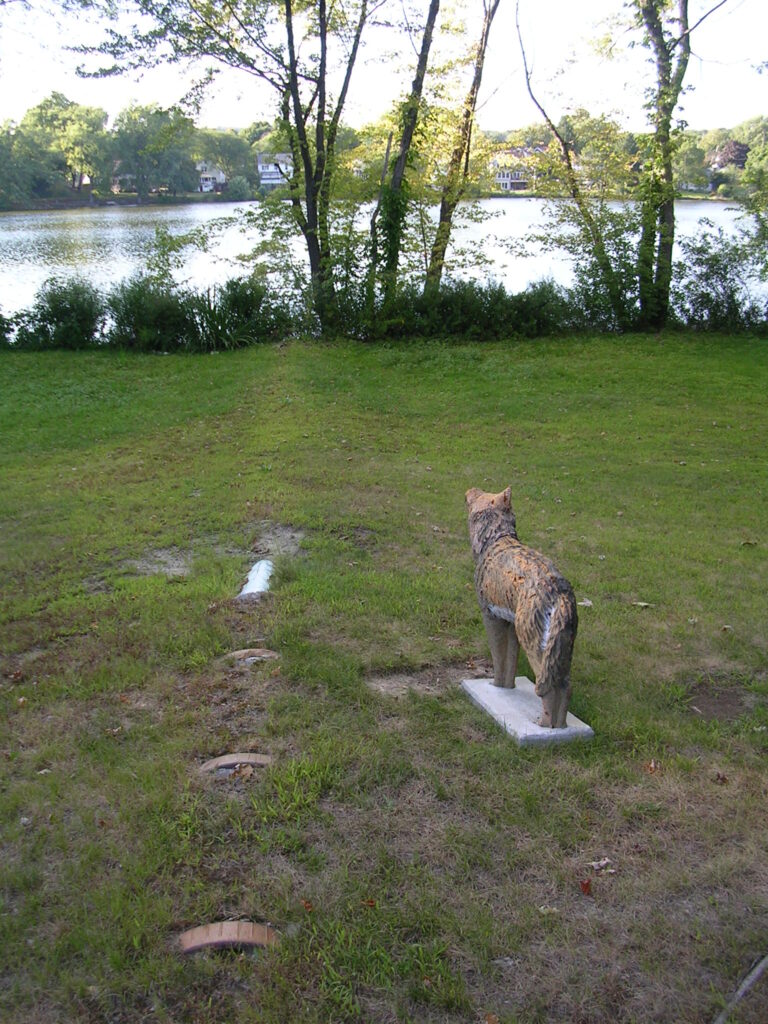
pond w/fox 3
It was about the size of a German shepherd, but it had a tail more like that of a fox; its muzzle was broken off. It seemed to be made out of sculpted plastic foam, eroded by time. Its surface was pocked and its coloring uneven, but this didn’t actually detract from its already anomalous appearance. I figured it was put there to keep geese from hanging out on the lawn and covering it with geese poop, but as soon as I started taking a picture of it, it struck me as more of an art work. If this were installation art, what would it be saying? Something about humans and nature.
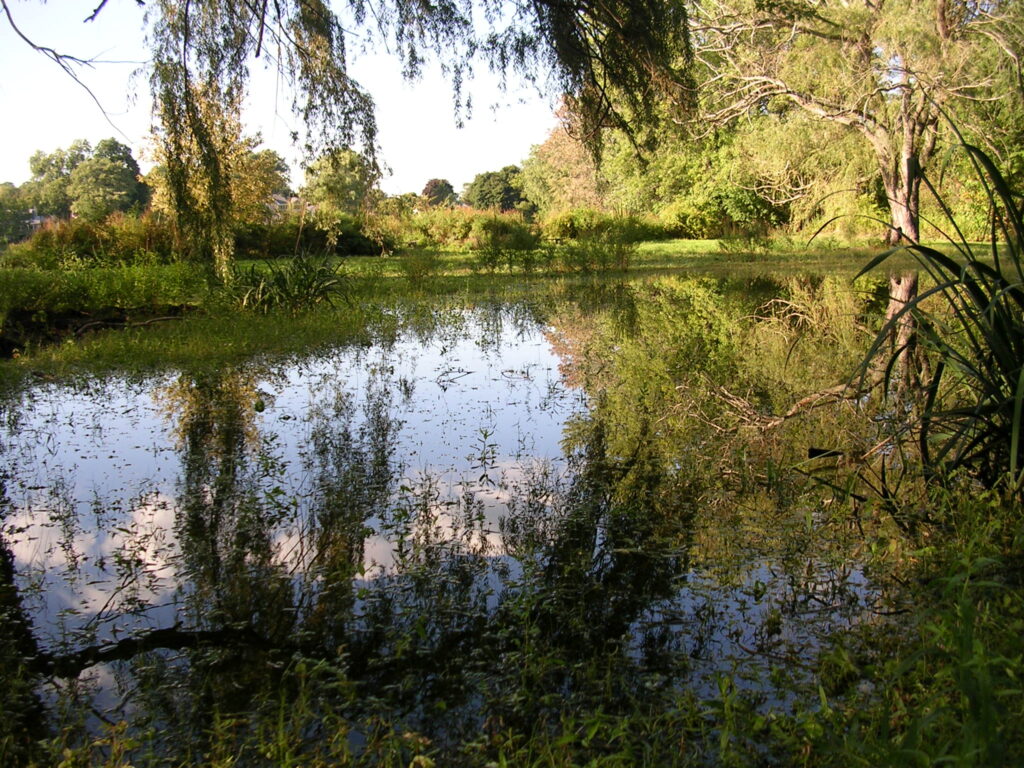
pool at Hill Estates
There was a pool of clear water in a low spot in the lawn, maybe twenty by thirty feet in area, and six inches deep. It had no edge; the grass of the lawn continued into the water. It looked like a vernal pool, but it seems to remain year-round. Beyond this pool, two more plastic canines stood looking in different directions.
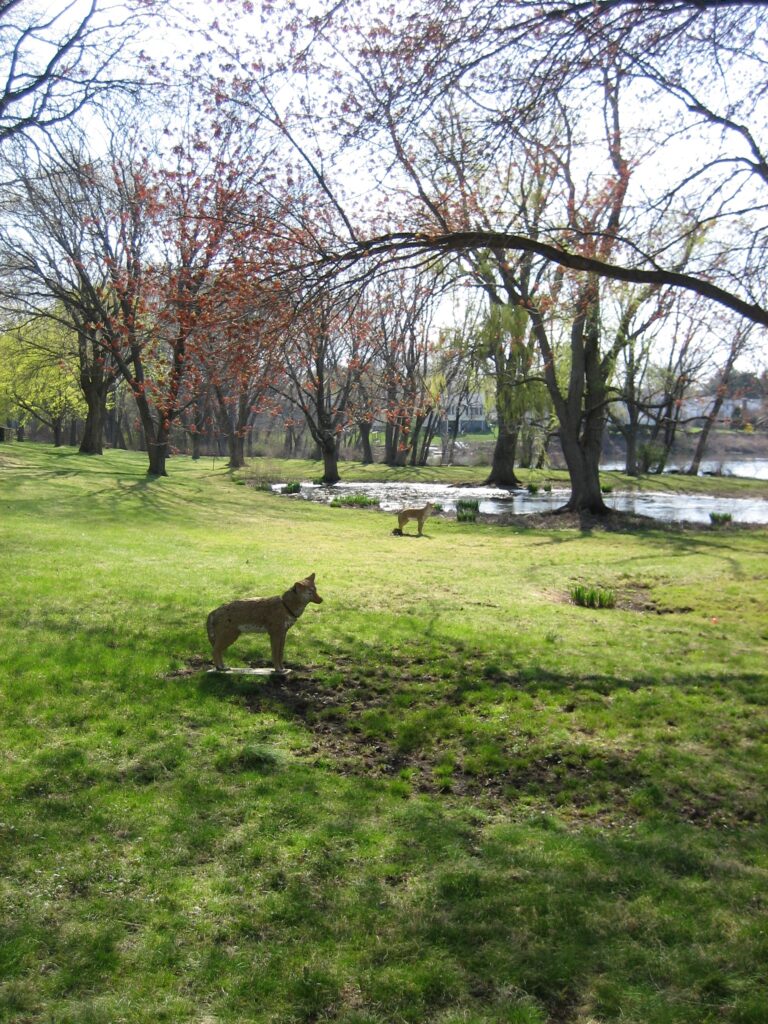
It would have been easy to read them as a snarky commentary: see, we replace nature with a tacky plastic simulacrum. But that seemed too predictable. If this were an archeological site, and these were ancient statues, they would be called totemic animals, guardian spirits of the place. Fragments of an animistic nature religion. Maybe they still carried some meaning like that, or maybe they were just styrofoam geese discouragers. Or both: that was the ambiguous thought that felt right.
Those plastic creatures were in a sense an imaginary “nature.” They were created by humans and they didn’t precisely resemble any actual animal. They were too big to be a fox, their ears and nose weren’t long and pointed enough for a coyote, their legs weren’t long enough to be a coyote’s either. When I came along and photographed them, they became, for a moment, a metaphor for our place in the natural world. They were also a fact in the environment, not just by physically being there, but also because it appeared they really did keep the geese off the grass. In which case they actually interacted with living creatures. And even the geese are simultaneously wild and quasi-domesticated; they live in Boston year-round, having given up migration in favor of permanent residence in the city. The natural and the contrived, the wild and the domestic, are tangled together and can’t be teased apart.
Is this collaboration with nature? It certainly is tending in that direction. In the conversation between geese and people at Hill Estates, a lot is going on. The geese have decided to live in Boston, and they must like Little Pond a lot. At Hill Estates there’s a nice big expanse of grass at the water’s edge, an excellent spot for them to hang around and forage when they’re not on the water. People are probably happy to see geese going about their daily lives around them, but they don’t enjoy greenish-blackish cylinders of geese poop squishing underfoot when they walk across the grass. What to do? Well, they could shoot some geese, barbecue them on the lawn, and eat them, and probably the others would decide to stay away. But using a little imagination and putting the plastic “coyotes” out there is like substituting language for shotguns; it’s like finding the right words to say so that people and geese can coexist. And if it works – which it seems to, at Hill Estates – then perhaps that even says the geese have heard what we’re saying and agreed to play along.
Little Pond is the source of the Little River, a stream that flows about a mile through conservation land known as the Alewife Reservation and at a certain point changes its name to Alewife Brook, which in turn flows to the Mystic River. Alewife Brook was so named because the alewives – herring – used to run up it in great numbers every spring; many fewer of them still come up the Mystic River, and probably a few even make it into the brook. The Alewife Reservation is the present-day name for much of the area once known as the Fresh Pond Marshes; the Little River’s current channel was dug a century ago, in an effort to improve the drainage. The old channel of the Little River still exists as wetland, and water continues to flow from the old channel to the new. The landscape preserves a memory of what it was before that particular intervention, which was far from the first; for centuries, people have been engineering this watershed, by digging ditches to drain fields, re-channeling streams, damming Alewife Brook, setting up fish weirs, and so on, for different reasons at different times. Today there is a large subway station, also known as Alewife, in what were the marshes, with a massive parking garage for commuters from the suburbs who come down a major highway known as Route 2. If you superimpose Rt. 2 on a map of the Fresh Pond Marshes circa 1866, it crosses what was then a “Cart path shaded by willows” and the “Site of former Heronry of Night Herons, also of Robin Roost.” But watch out for rural nostalgia – in the 19th century, also, a slaughterhouse operated in the area and dumped its wastes into the marsh. Malaria was a serious local threat in 1900. At a meeting of the Cambridge Board of Health in August of that year, the public angrily demanded action to clean up nearby waterways.
The Alewife subway station is situated at the point where the Little River flows under Route 2 and becomes Alewife Brook. It’s a complicated geographical nexus. Where an overpass crosses over an onramp to Route 2 there is, as in many such places, an access point to a landscape that is usually ignored. No one driving by in a car, focusing on getting onto the highway, would ever notice this, but on a bicycle or on foot the world has much finer detail. On either side of the overpass, along the foot of the embankment, there’s a path made by people’s feet. On one side, the path leads to a fairly sizable body of water known as Yates Pond, across the road from the parking garage, where geese upend themselves to root in the mud of the bottom, and ducks make paths through the floating duckweed. Turtles sun themselves on logs.
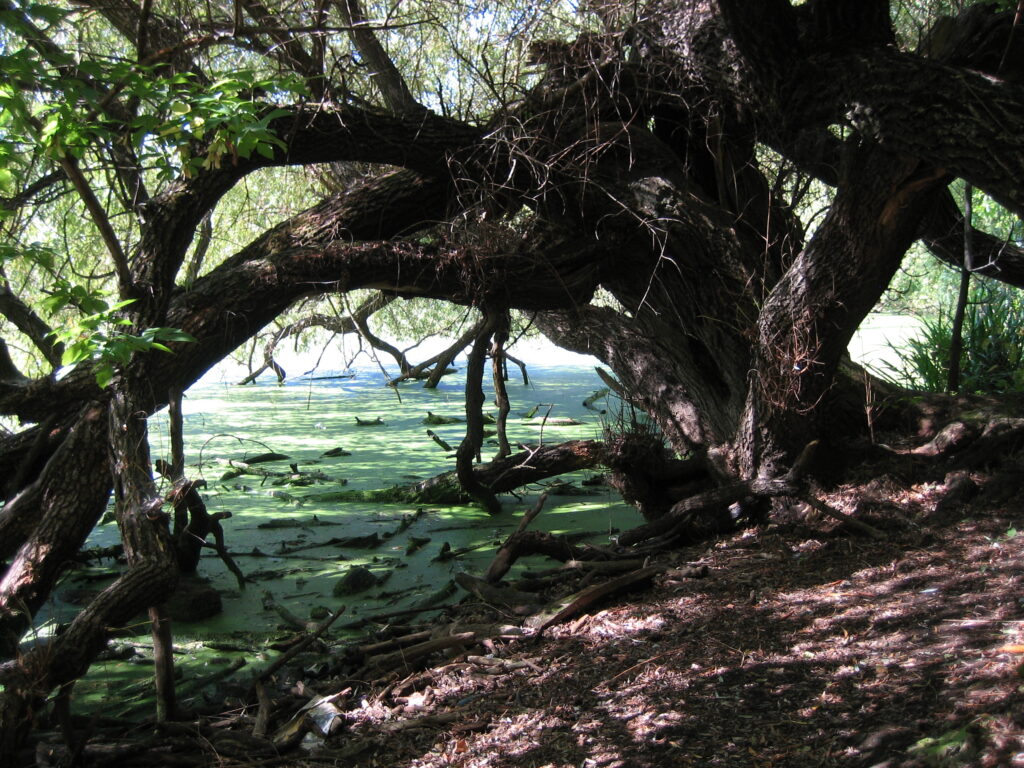
Maybe thirty feet from the roadway, a person can sit under the massive gnarled branches of an old tree and contemplate this scene, undisturbed and undistracted.
On the other side of the overpass is a smaller pond with no name, on which water lilies were growing in September of 2007.
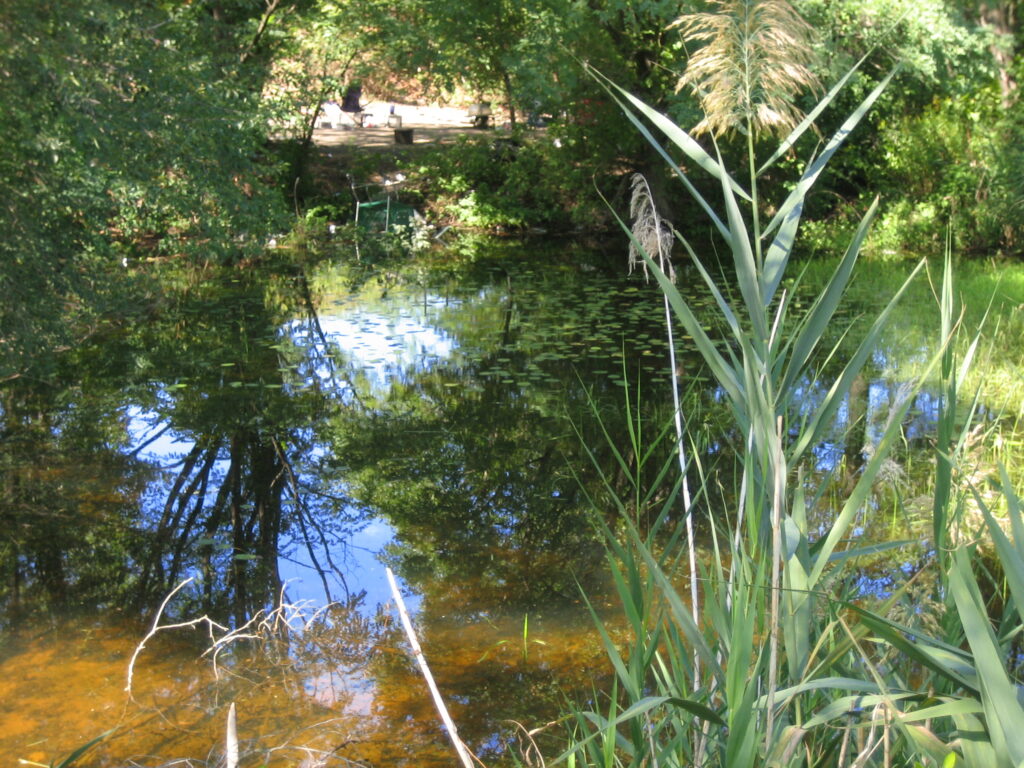
The path on this side leads to a clearing used by homeless people; there were shopping carts there, the usual plastic milk crates, a couple of chairs, a piece of plywood in use as a table. Rolls of toilet paper. Empty beer cans, soda cans, Luna Bar wrappers. Newspapers. This spot had a beautiful view, looking out over the small pond.
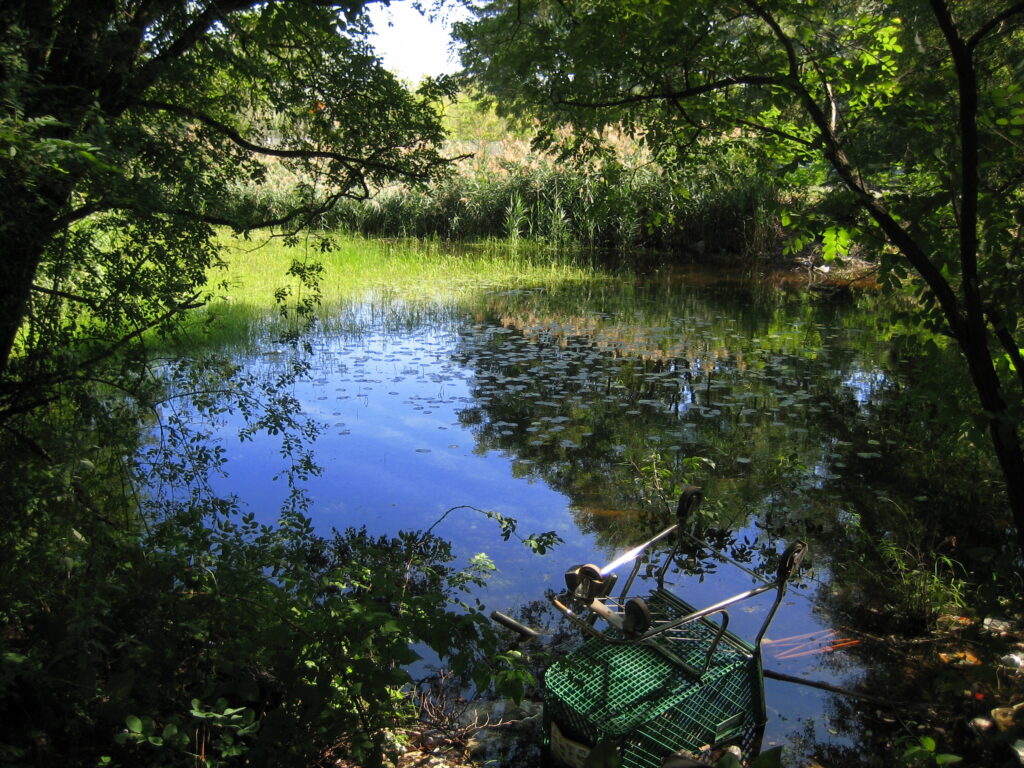
I met a couple of young guys there and chatted with them for a while; they seemed the opposite of the stereotype of homeless people – more like college students, which, for all I know, they may have been. Apparently they were doing the same thing I was, except they were doing it all day: being there, enjoying the place. They were happy to talk about the birds and animals they’d seen there. They had better bicycles than mine, which they kindly pronounced “old school.” When I said most people never experience this, even though it’s so close to the road, one said, “Most people are too programmed to do this.”
I tried some different trails on my bike and eventually ended up at the back of the parking garage, where a stream shaded by trees runs alongside its tall, curved, graffiti’d concrete wall.
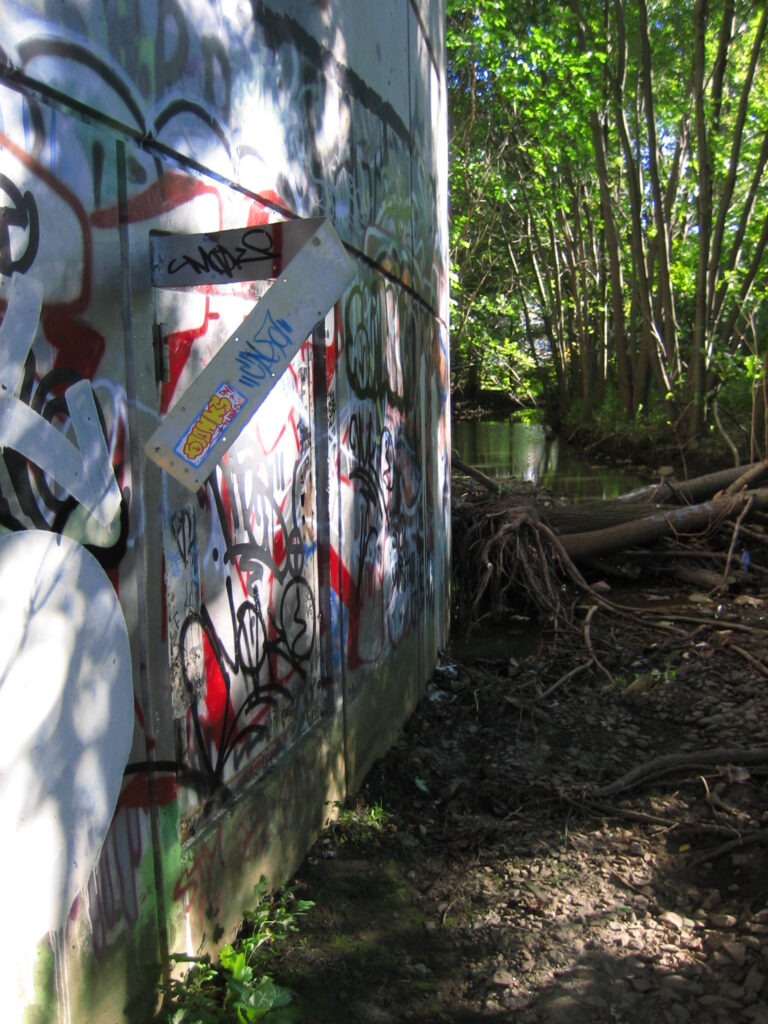
At the point where the stream emerges from a culvert it is labeled in this way:
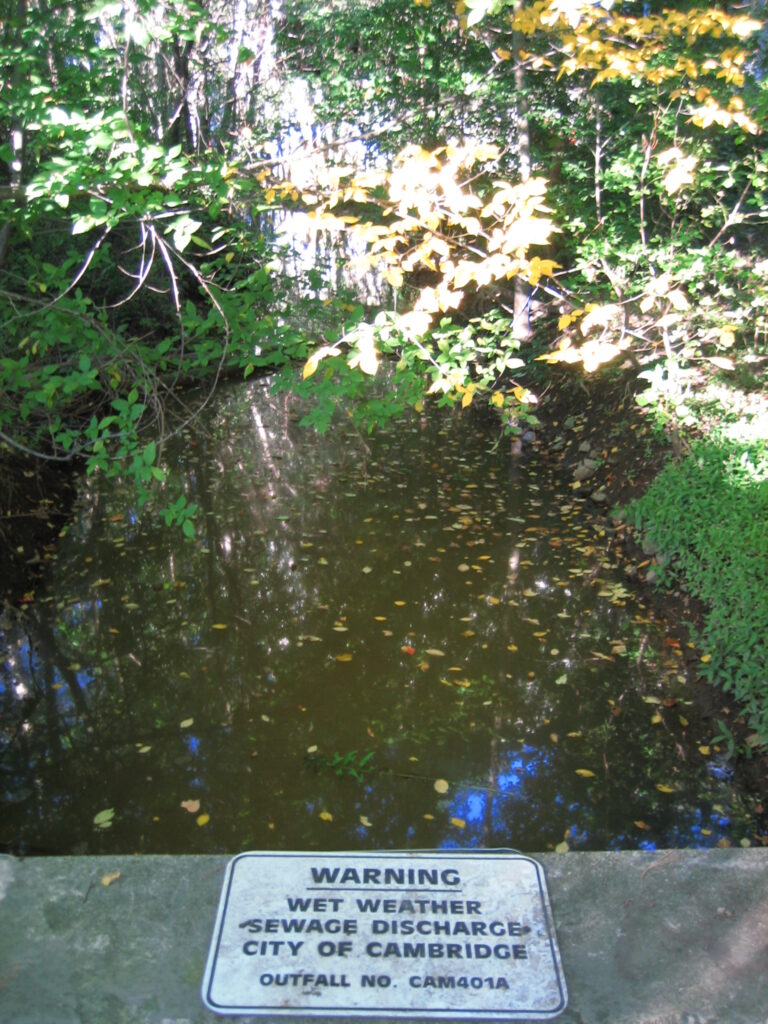
In a heavy rain, the sewers exceed their capacity, storm runoff mixes with sewage, and some of it comes out here. Could there be 401 such outfall points in Cambridge alone? I certainly hope not. There was a piece of pink tape tied to a tree that read WETLAND DELINEATION. Before starting to explore the neighborhood, when I thought “wetland,” this would not have been what I thought of. But that didn’t stop it from being one. In principle, wetlands have the ability to purify water by biological means, so in a sense, if there must be a combined sewage outfall, maybe this is where it should go. Much better for there not to be one, of course.
But the peculiar truth is that the place appealed to me. If it hadn’t been for the sign, the idea of sewage would not have crossed my mind, and somehow the graffiti and the rough concrete complemented this totally unprepossessing waterway and woods in a peaceable fashion. The graffiti in this context seemed quieter than graffiti elsewhere and less disruptive. The situation formed some sort of whole, unless what I was seeing was evidence of my mindscape projecting itself on the environment.
Back home, I picked up a little book about wabi-sabi, a Japanese aesthetic that is associated with tea ceremony; it turns out that wabi-sabi is also a way to think about Outfall No. CAM401A. “Wabi-sabi,” the author (Leonard Koren) says, “is ambivalent about separating beauty from non-beauty or ugliness. The beauty of wabi-sabi is, in one respect, the condition of coming to terms with what you consider ugly. Wabi-sabi suggests that beauty is a dynamic event that occurs between you and something else. Beauty can spontaneously occur at any moment given the proper circumstances, context, or point of view.” That pretty much said it all. Sewage outfall? Ugly. Also, a reminder of why the Fresh Pond Marshes became a public health problem in the first place. Graffiti? Ugly, at least some of the time. But somehow beauty spontaneously occurred, given my point of view.
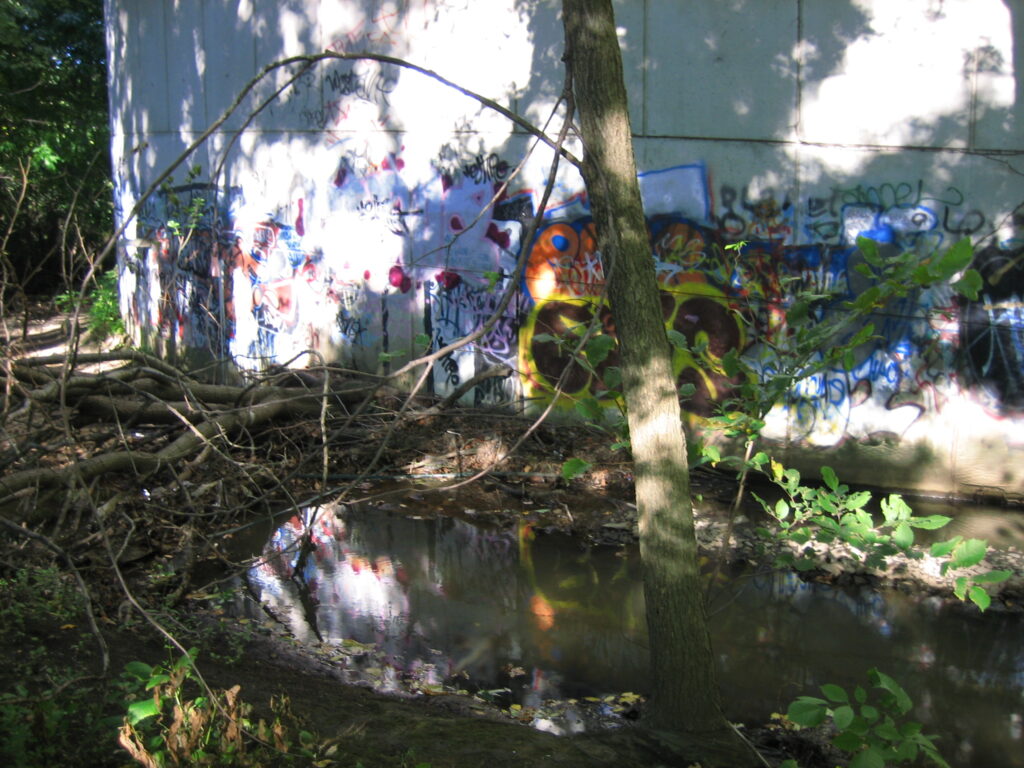
“Things wabi-sabi easily coexist with the rest of their environment.”
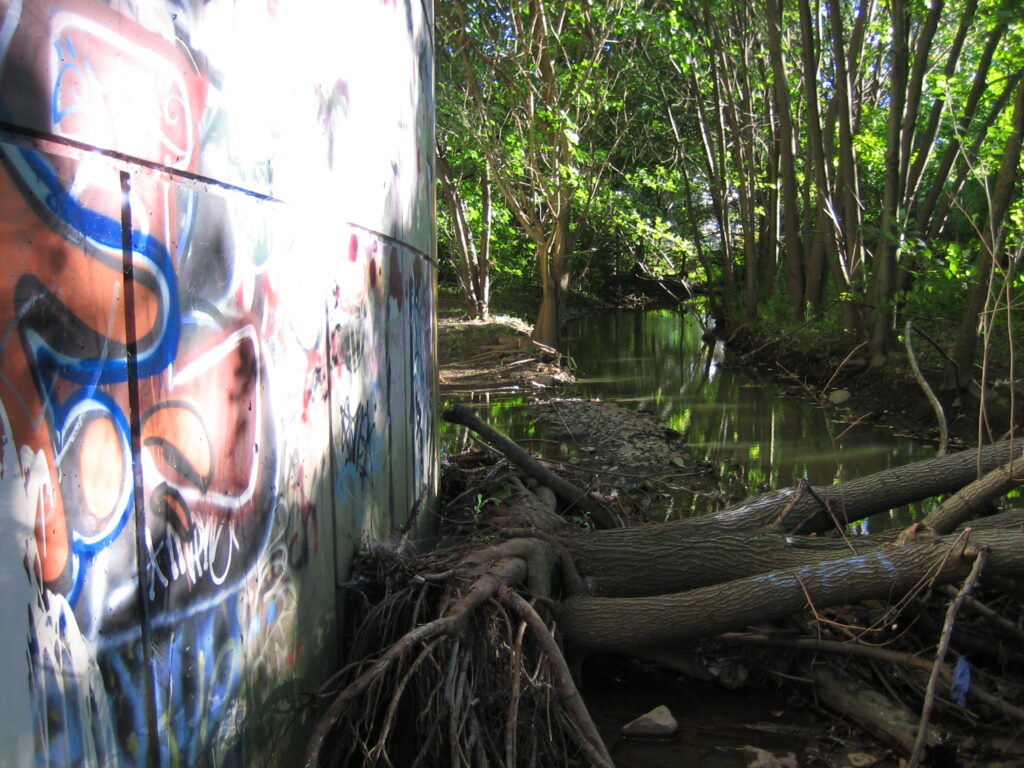
“Things wabi-sabi can appear coarse and unrefined. . . . They record the sun, wind, rain, heat, and cold in a language of discoloration, rust, tarnish, stain . . . a testament to histories of use and misuse.”
There was the mindset, the point of view that colored the encounter: an openness of categories, a lack of prejudgment. Discoloration was a color, visible evidence of misuse no less worthy than evidence of use, the graffiti not walled off from other art, CAM401A not cast out of the category of streams. That last perception was not mine alone. I saw a blue heron wading there on a later visit, and on a winter day, the footprint of a heron in snow on the bank.
*
In October of 2007, on the way to a Red Sox playoff game at Fenway Park, I took a little detour to the bank of the Charles on the downstream side of the Boston University Bridge, which is home to a colony of white geese.
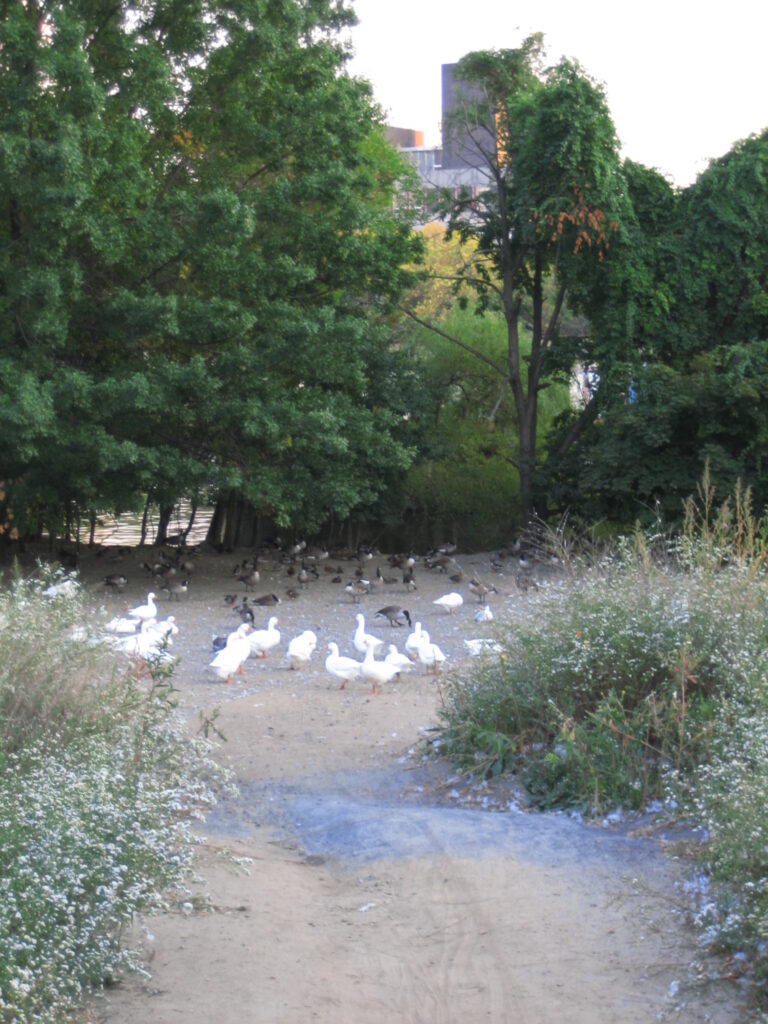
Their ancestors were brought there in the first place, about 25 years ago, as guard animals for a pumping station on the upriver side of the bridge, and since then they’ve decided it is their home. There have been various efforts on the part of the city of Cambridge and the Department of Conservation and Recreation to get them to go away, vociferously opposed by local residents who want them to stay. They’re clearly an emblem of nature for many people – on the website of the Friends of the White Geese, their habitat (maybe a mile of the riverbank) is dubiously referred to as an “urban wild” – and then there are others who think of them as pests. They look a lot like Embden geese, a common domesticated breed; they have heavy conical beaks and their heads are shaped differently from those of Canada geese. They are unwilling to move away from the one spot where they live, no matter how the city makes life difficult for them. In recent years, they’ve been prevented from feeding on part of the short stretch of riverbank they inhabit. What, I wondered, was preventing them from expanding the boundaries of their world in other directions? They’re geese! The river is open to them. And there’s a lot of other goose habitat around; why don’t they take advantage of it?
I showed up around dusk, as the white geese, some Canada geese, and quite a few ducks were starting to settle down for the night on land. The scene was both startling and comical in its incongruity: on the ground were dozens of large birds congregating to go to sleep, and right above them was a world of rush hour traffic. The white geese put up with my presence and my photographing; when I got too close for comfort they stuck their beaks in the air, eyed me sideways and edged away. But as I left they set up a concerted honking as if they were reproaching me: “You shouldn’t have bothered us! Don’t you know that?”
I wondered what would happen if someone planted a plastic fox there. But I wasn’t about to try it and become a big-time persona non grata to the Friends of the White Geese.
A few days later, my friend Stewart O’Nan sent me a clipping from the B.U. magazine about the white geese. It turns out that two residents of Cambridge feed them twice a day. Aha – no wonder they weren’t going anywhere. In the article was this quotation from Allison Blyler, one of those who feed the geese: “They are complex beings deserving of respect and care. Their presence provides a bridge to the natural world that many city dwellers would otherwise never cross.” One of them eats out of her hand. When she leaves, she says to him, “I’ll see you in the morning.”
Now I understood why the white geese honked in protest when I left, not when I came: they were saying “How can you leave without feeding us?”
One day in 2009, as I was riding my bike home from work at the height of rush hour, I came upon a state trooper at that same spot, directing traffic on the Cambridge end of the B.U. Bridge. She was holding up a long line of impatient cars because the white geese had decided to cross the street and forage on the median strip of Memorial Drive. Frustrated drivers farther up the line, who couldn’t see what was causing the hold-up, were honking their horns. The geese were lined up on the narrow path leading from their home base on the riverbank, crossing the street almost in single file. After a while, those who were still on the sidewalk seemed less eager to cross; they hesitated just a bit, and the trooper held up her hand palm forward, telling the geese to stop the same way she would any other pedestrians. They stopped. She motioned the traffic to move along. For a while the cars proceeded as usual, and more geese built up on the sidewalk and the path leading to it, visibly waiting to cross. The trooper decided their turn had come; she stopped the cars, and then she waved her hand in a circular beckoning gesture, telling the geese they could go, exactly the way a cop would tell a bunch of people on foot. When the geese got the signal, they went.
The words “urban wild” don’t come close to capturing this. “Wild” is not what the white geese are; they’re about as domestic as a Rhode Island Red. Allison Blyler may have come closer when she said “they provide a bridge to the natural world.” The key word, I think, is “bridge”: something with one foot planted on each side of a difference. The geese themselves are an anomalous boundary condition, an impure nature. These particular geese and that particular state trooper definitely knew how to collaborate; they seemed to have a shared understanding built up by some confluence of human culture, geese and people having a history together, geese learning from each other. One thing seemed clear in the rush hour incident: the geese had as much autonomy as the drivers, and the cop knew that and acted on it. Their traffic pattern was just one more part of rush hour, which is not only amusing but hints at a world that could be.
*
After a number of local expeditions looking for the boundary zone, the ecotone not just of flora and fauna but of hitherto compartmentalized assumptions, I came to believe that every journey is rewarded. Apparently if I looked, I would find, because such places exist and I brought with me a mindset ready to perceive them.
One of my favorite finds is a few miles upstream from Cambridge, where a stream called Sickle Brook turns into a wetland and flows past the parking lot of a towing company, full of tow trucks, presumably towed cars, and a number of scary-looking wrecks.
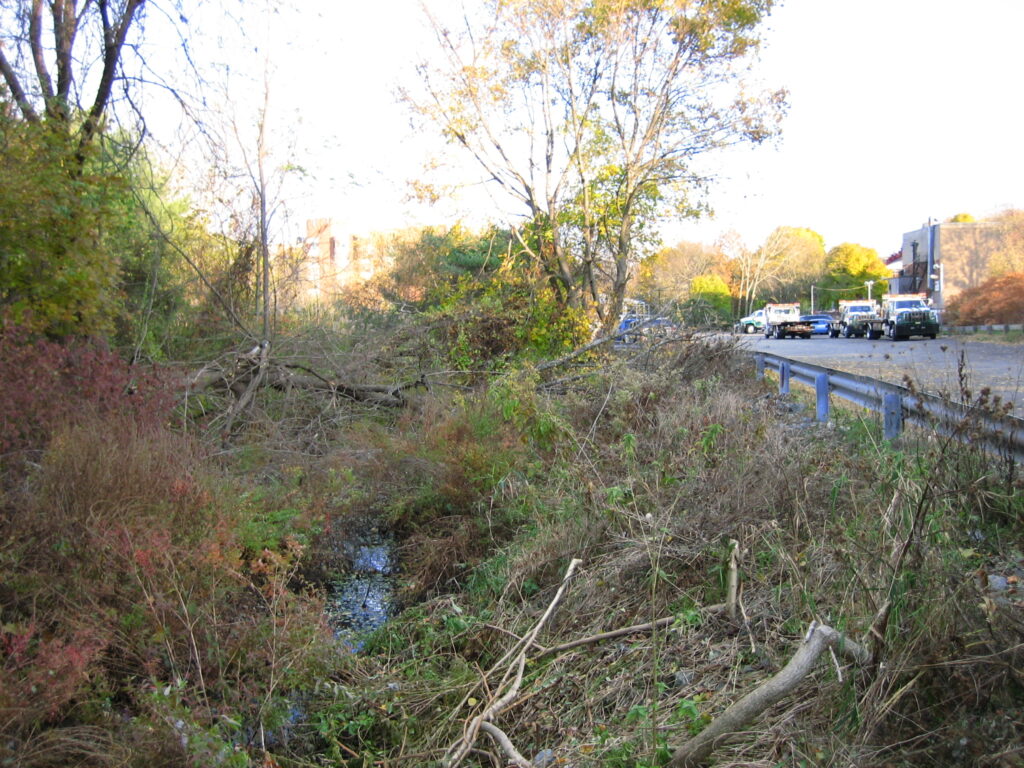
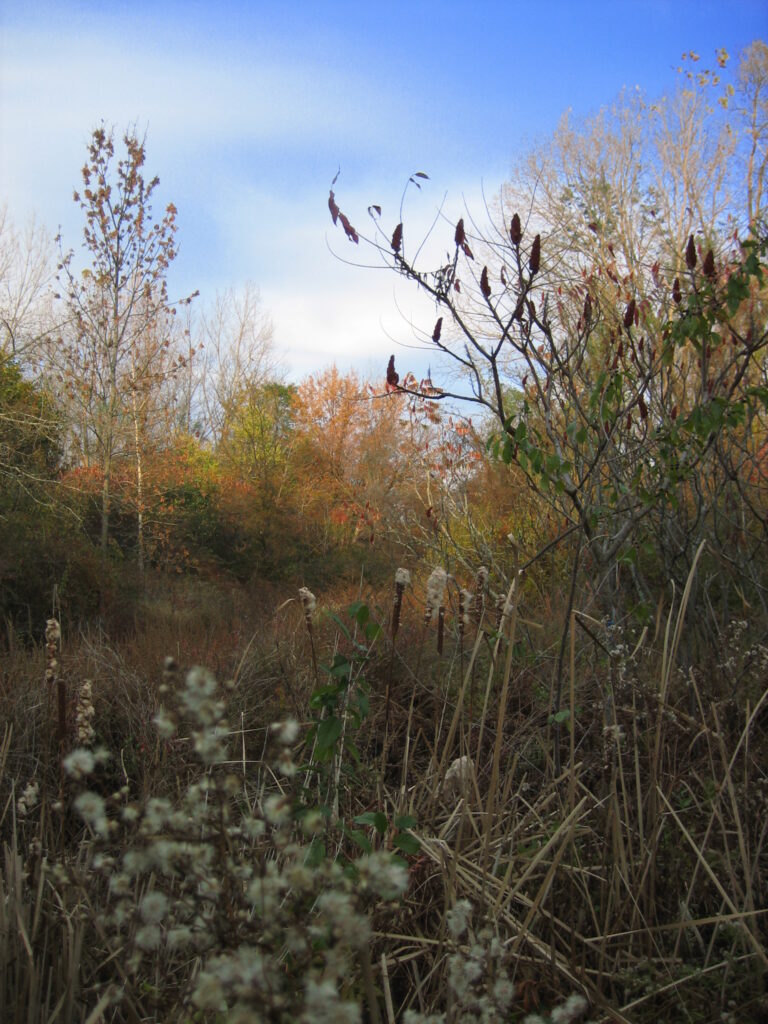
On a November afternoon, the wetland itself was unambiguously beautiful; the tow lot unequivocally was not.
Most curiously, in the brief transition zone between them, someone had built a substantial arbor which was festooned with dead vines; it appeared that in this unlikely spot someone had taken up vegetable gardening.
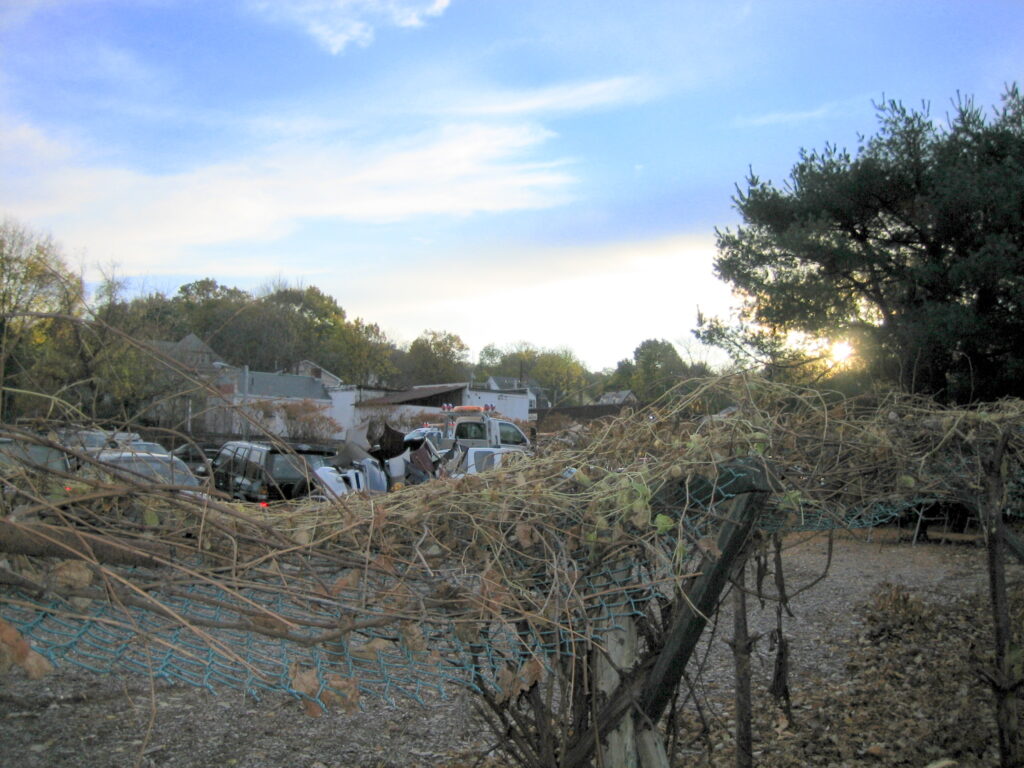
That arbor stood in, and seemed to acknowledge, the ecotone between the tow lot, which was humanly determined to the nth degree, and the wetland growing in its own self-organizing way. What I am trying to call attention to, which is all around us, is that liminal space that is neither “nature” nor “not nature.” It is neither a marsh nor a parking lot but the invisible threshhold between the two. It is the point – any point, anywhere – at which we come upon evidence that the life around us is finding its own way, not under our control. The crucial point about this boundary is that it is permeable, it is open; it is the gap in the fence, the barrier low enough to step over, a border that is not mapped or patrolled. This ecotone reveals the ongoing, though often ignored and neglected, relationship between human agency and the autonomous self-organization of the life around us, a relationship that must be one of equality. No matter what we may have thought in the past, our choice now is not between being the natural world’s master or its victim, nor is it a choice between being its savior or its destroyer; we’re faced with a choice between equality and a failed relationship.
What I mean by equality can be seen in a small way in the plastic animal, whatever it is, at Hill Estates. The plastic creature is a representation, totally in human terms, but putting it there is not representation. It’s an act of relationship, a gesture, an instigation. The plastic creature’s presence on the lawn next to Little Pond is open to interactions we don’t control. By putting it there we precipitate a narrative that is ongoing and undetermined; we don’t know how our co-authors, the geese, are going to play their part. They have just as much freedom to choose how to react as we have freedom to put it there. This event becomes a true collaboration.
In my local travels looking for the boundary zone I’ve trained myself, by imperceptible degrees, to notice a certain kind of beauty that wasn’t available to me before. It waits in the messy parts of the immediate environment, the parts we haven’t organized into a state of excessive order, like the plant life along fence lines or in roadside ditches, wetlands, marshes, swamps, nameless streams and ponds, minimally managed conservation land, vacant lots, human spaces returning to nature. This is the beauty of the useless and the mostly ignored or taken for granted. Every once in a while beauty bursts out in something unmistakable like a swan that came swimming along the Little River one day while I was walking there, but most of the time it is hidden in plain sight, invisible beauty until it is seen.
I think that because beauty is “useless,” noticing it, focusing on it, valuing it, is a way to see around the hard-wired human tendency to view all situations in terms of meeting our immediate needs. It helps a great deal to notice what happens when nature is NOT under our control, because we are always depending on it to do more than we know how to tell it to do. Spontaneously occurring beauty lacks utility in the sense that it won’t write anyone a paycheck, but the ability to perceive this kind of beauty is a survival-promoting trait. It tells us when we’re in an environment with which we are congruent. Whether we see it or not is entirely about the mind and the way we imagine the living world around us.
The marshy edge of a stream or pond reflects the sky, and is like the sky: open, indeterminate, priceless. But unlike the sky, we can touch it, it is right here at our scale of being. The muddy edge of Sickle Brook has no obvious function; it is unmarked, it has no designated role. By not being labeled nature, it is nature. And it is already there. We not only enter it; if we allow it to, it enters us. It is not something we preserve, exactly, just as we don’t “preserve” the people we love; they are, and we’re glad that they are, but they don’t exist because of us. We are just lucky enough to be on the earth at the same time they are.
Beauty lurks on a certain kind of boundary line, one that does not make too definite a distinction between the human and the natural. It’s too late for us to leave nature alone, but that’s okay. It already was too late when we evolved into the kind of creatures we are today. A “pure” or pristine nature is not an option. But this does not mean that we are authorized to run to the opposite extreme, of total domination and control. We overreach when we imagine we can harden the boundary and get nature to leave us alone, or pull it completely into the human sphere and make it operate solely for our convenience. The thing we have to defend and preserve is the permeable, indeterminate boundary between us and the autonomous life around us. If we do that and make good choices, then we can keep living in a hybrid world made up of nature and our human constructions in an equal and collaborative relationship. And such a world has plenty to offer.
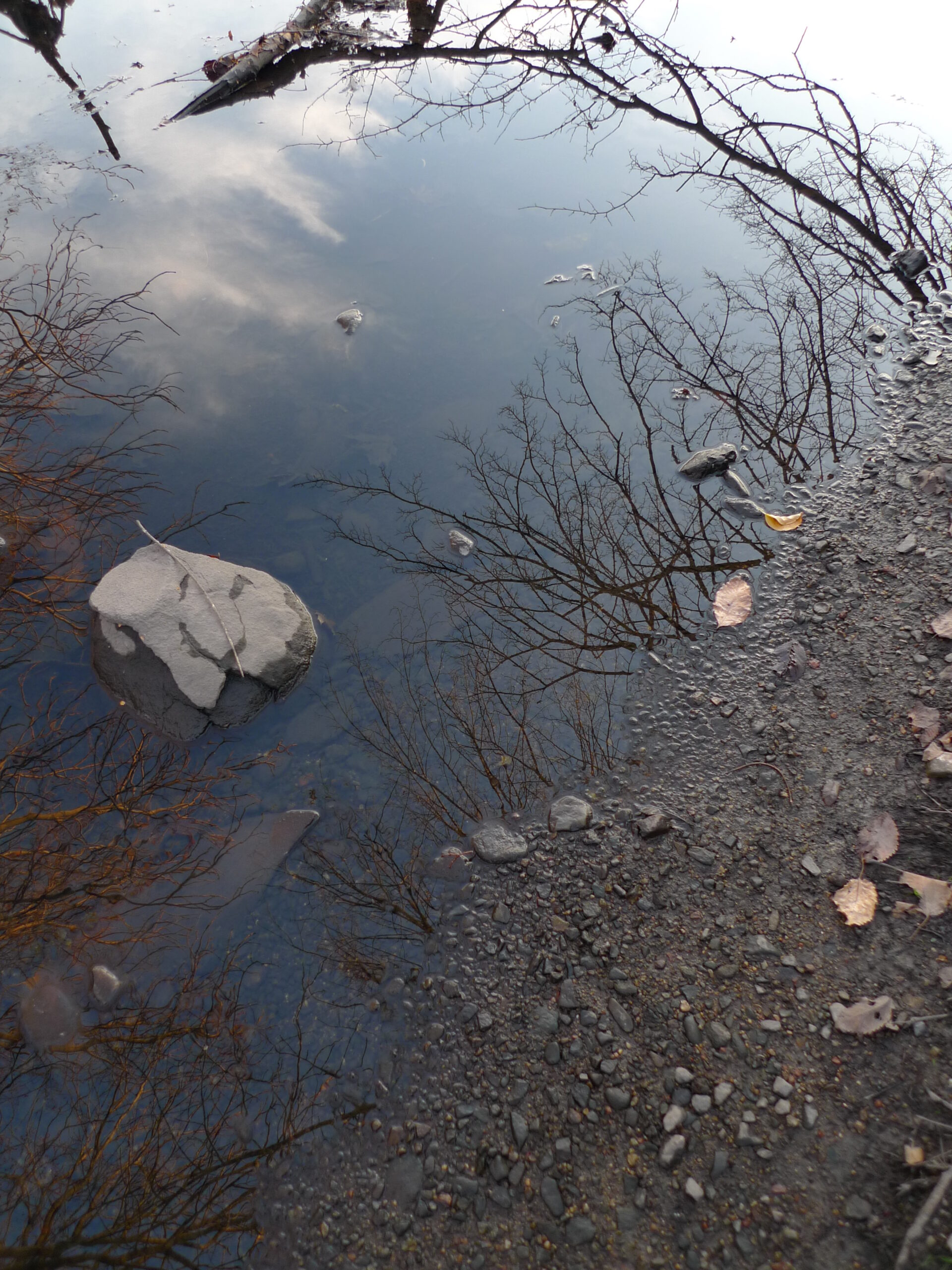
The muddy edge of sky is at our feet. All we have to do is keep looking until we see.
NOTES
The quoted definition of “ecotone” appears as an epigraph to each issue of the journal Ecotone, published by the University of North Carolina, Wilmington.
Map of Fresh Pond Marshes, ca. 1866, with quoted inscriptions, found in William Brewster, Birds of the Cambridge Region. Memoirs of the Nuttall Ornithological Club, no. 4 in a series, 1906.
Leonard Koren, Wabi-Sabi for Artists, Designers, Poets & Philosophers. Berkeley, CA: Stone Bridge Press, 1994.
